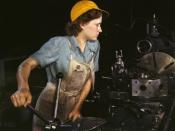Gender differences in the workplace
Within the last thirty years, women have entered the workforce in record numbers. Today, it is more likely to meet a woman who works outside of the house than to meet a woman who does not. Females are now in management positions all over the nation also in professions that were previously reserved for men. As the number of females who enter the workplace increases, the gender differences are becoming more apparent.
Many more women have been entering high-tech fields in the last two decades. By 1996, thirty-nine percent of all computer programmers were women. "Women are also making slow but steady progress in entering nontraditional fields such as engineering, professions such as medicine and law, and elected and appointed political positions" ("Women" Para. 7).
In many nonwestern nations the discrimination of workers based on their gender is an accepted practice, however, in the U.S.
and Canada it is illegal, though it still occurs. For example "in Canada women on average earn only eighty cents on every dollar males would make" ("Workplace 6"). The common excuse is that males have a greater workload than women and at work are asked to apply themselves physically more so than a woman would.
The origin of sex discrimination in the workforce first came about because of physical differences between men and women. Whether or not a female can do the same job as a male came into question, when females began to take jobs that used to be considered "male jobs". An example would be a firefighter. Women need physical endurance to perform tasks such as chopping wood, climbing ladders and carrying fire victims out of burning buildings in order to become a firefighter. If a woman is capable of doing what is asked of any firefighter,


